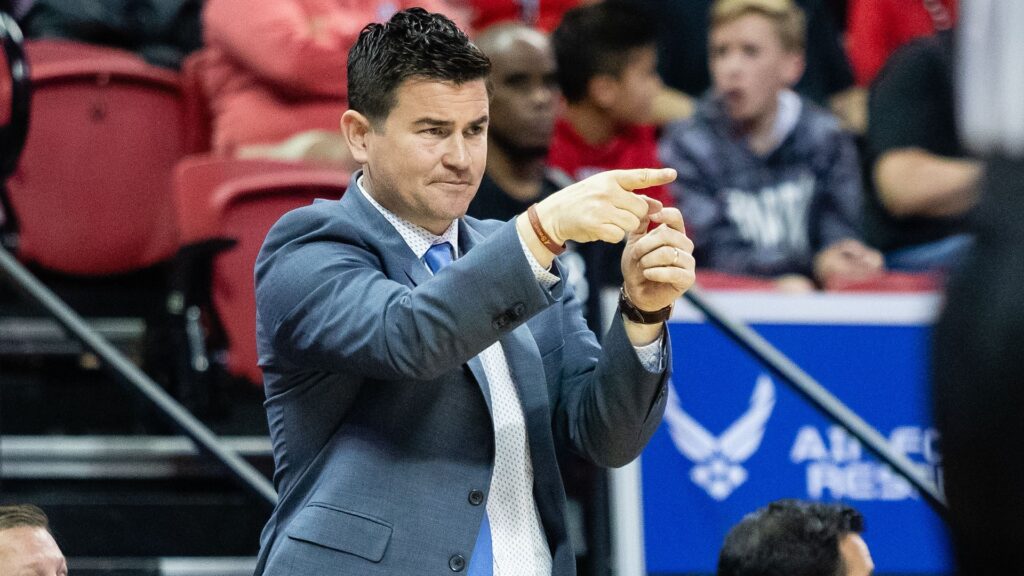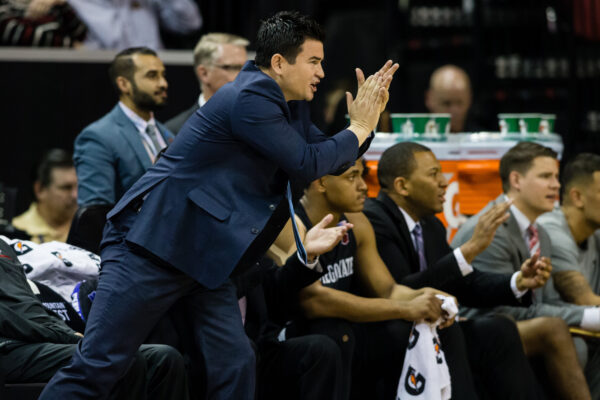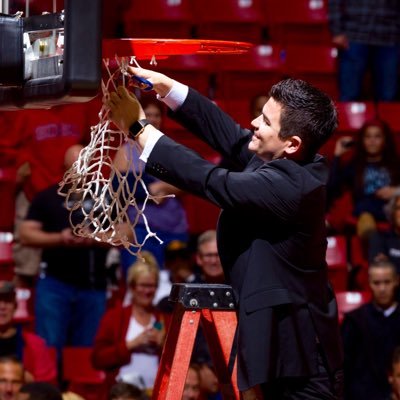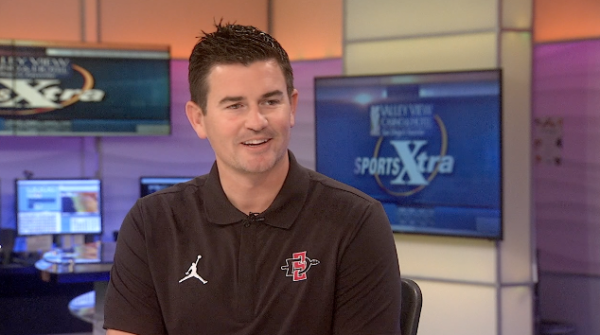SDSU’s Dave Velasquez: Born to coach

Credit: Go Aztecs

The Journey
When incoming freshman Demarshay Johnson Jr arrives on the Mesa this year, he will be 17 years old. He was not even born when SDSU Assistant Coach Dave Velasquez became an Aztec. Velasquez is entering his 20th season with the school. During the two decades, Velasquez’ experience as a student manager, a scholarship athlete, the director of player development, and now as an assistant coach has given him the most unique perspective on the rise of SDSU basketball. Others can talk about what it takes to build a winning program, Velasquez has seen it firsthand. All from his happy place.
“(Coaching) is just something I’ve always wanted to do, to be honest with you,” Velasquez told the East Village Times in an exclusive interview. “I don’t know exactly when, but my life was in a gym, and it’s still is in a gym. The gyms are a little bit more packed now with a lot better players than I was around. But I’ve always been in a gym, and I can’t see myself anywhere else. Really, my happy place is to be in that gym working guys out at practice. There’s no place better for me than there.”
The love of basketball and helping others grow on and off the court was never a conscious choice. From a young age, he was immersed in the game. The youngest of three boys, Velasquez’s father was a coach, and the setting in which he raised his sons was a basketball court.
Unsurprisingly given this backdrop, one of Velasquez’ greatest attributes is his expertise in player development. At SDSU, his training in the art began early. As a student, his roommate was Brandon Heath, the school’s all-time leading scorer. At 6 am, nearly every morning, outside of the eyes of fans, the media, or even the coaches, the two friends would get up to work on their craft.
This was before SDSU’s state-of-the-art basketball facility, the Jam Center, was built, so Velasquez and Heath would go down to the Aztec Recreation Center (ARC) or find a way to sneak into Peterson’s Gym when the ARC was unavailable. This experience watching Heath blossom on the court and in the classroom was the perfect laboratory for what Velasquez is building his reputation on as a professional.
Years later, in early 2018, Velasquez and Aztec Head Coach Brian Dutcher sat in a Starbucks in Pullman, Washington, trying to convince Washington State transfer Malachi Flynn to entrust his basketball future to the coaches at SDSU. The trouble was, at the time, there were only two coaches on staff. Justin Hutson and Tim Shelton had just left to take over the program at Fresno State, leaving two vacancies on the staff.
Their recruiting pitch to Flynn was that despite being an All-Pac 12 performer, he was not anyone’s NBA radar, and if he came to SDSU, they would work with him every day to make him better. With honesty and candor that is in short supply in college basketball, they spelled out for Flynn the deficiencies in his game and their plan of attack for how they were going to address them. More importantly, they pledged to be with him every step of his journey. They kept their promise.
“Yeah, definitely,” Malachi Flynn told EVT when asked if there is anything special about SDSU that helps them develop players. “Their coaches, that’s a priority for them. They take everybody – it was not just myself or Jalen (McDaniels) – really from top to bottom you can see their progression, so that is definitely something the coaches put their effort in.”
Remembering Aztec Nation
December 7, 2002, Evan Burns, still the most highly decorated recruit to ever suit up for SDSU played his first collegiate game on his home court against the number one team in the nation, the Arizona Wildcats. All eyes were on the McDonald All-American as he checked into the game. The Aztecs were in possession, up one. Point Guard Deandre Moore brought the ball up the court and found Burns for an alley-oop dunk in front of the student section, all clad in white “Fisher Fanatics” t-shirts.
That game was the first sellout in the history of the new on-campus arena, and the moments after Burns flushed the lob from Moore was the birth of the “Madhouse on the Mesa.” The roar of the crowd was deafening. 12, 414 screaming supporters announced to the world: major college basketball had come to San Diego. Velasquez, a freshman student manager, took it all in. It was a moment he has never forgotten.

“There’s obviously great memories and of when Viejas was full,” Velasquez explained when asked what has stayed with him from his time as a student. “I remember, there was an Arizona game we played. Evan Burns was on the team. To feel that for the first time ever, ‘okay, this is as loud as this gym can get.’ I’ll never forget the feeling (and thinking), ‘What if we can get to this every night, that feeling from the Arizona game?’ Now, we’re there, and so as a manager, it was almost a pipe dream to think that we can get Viejas full every night. We heard coach Fisher talk about it, and now, it’s a reality.”
As much as the individual moments for Velasquez, the overall arc of the program stands out to him. Velasquez is a historian of SDSU basketball. He speaks with the same passion and enjoyment about every person who has come into the program, from a walk-on like Narbeh Ebrahimian to Kawhi Leonard.
Better than anyone, Velasquez can tell the lore of the Aztecs. How players like Moore and Mike Mackell laid a foundation for Brandon Heath, Marcus Slaughter, Mohammed Abukar, Richie Williams, and John Sharper to come in and take the program to new heights. Those players raised the status of the program enough for Lorenzo Wade to transfer from Louisville and Kyle Spain to come in as a freshman and cement the change in the culture.
With the culture of winning established, Billy White, Malcolm Thomas, Chase Tapley, Kawhi Leonard, and DJ Gay arrived and impossibly went 34-3 before handing the program to Jamaal Franklin, Skylar Spencer, Dakari Allen, Xavier Thames, JJ O’Brien, Winston Shepard and Josh Davis who proved SDSU had more than one good year and was a true program. Into the present with Yanni Wetzell, Flynn, Matt Mitchell, Jordan Schakel, and Adam Seiko leading the next wave of Aztecs like Lamont Butler, who Velasquez says, “is a perfect example of what San Diego State basketball is all about.”
“It’s sometimes hard to tell the older guys even how much we appreciate them,” Velasquez said. “I wish we could do more for all of them. …”
“There’s a whole stretch of guys. It’s just incredible how good they were for San Diego State. It’s incredible how, at times, they get overlooked a little bit for no reason than the fact these past couple years, these teams have been really, really, freaking good. There’s a lot of people and a lot of hands into how San Diego State has been molded. It’s like a Picasso painting, if you will, that we have to continue to the manicure and continue to paint on and get better.”
The Path Ahead
With the success of players like Flynn, Velasquez appears poised to join Dutcher and Hutson as former Fisher lieutenants who have made the 18 inch move from the assistant to the head coach’s chair. Watching two of his colleagues assume the responsibility for an entire program and how their roles changed as a result has been a priceless education, but what has prepared him even more to run his own team is the unique way coach Fisher and now coach Dutcher operate.
CONGRATULATIONS TO MY GUY COACH HUT! He has been a great friend, generous mentor and outstanding coach. Going to miss competing every day with him. He will forever be a part of the Aztec family. Good luck Hutty! pic.twitter.com/cMvRywntqW
— Dave Velasquez (@DaveV_SDSUHoops) April 5, 2018
“There’s a lot of things where coach Dutcher has a very selfless attitude,” Velasquez explained. “Probably the lowest ego, maybe in all college basketball, from a head coaching standpoint. He lets his guys work. He never wants any of the credit, never expects to take any of the credit, and when we lose, he takes all the blame. He doesn’t come in and say, ‘well, you guys didn’t do this.’ He never does that behind closed doors. He never does that publicly. He never does that to our guys. There’s so much strength to that, and that gives you so much confidence to continue to work and get the team better, which is the most important thing.”
Dutcher’s leadership style allows his assistant’s freedom to work. Unlike most places around the country, SDSU is not micromanaged by its head coach. Velasquez, along with Jay Morris and Chris Acker, recruit players on their own without the head coach present. It is their responsibility to design the practice plans. They are able to stop the practice or a film session at any time to address the team. The norm in college basketball is to divide the roster among the assistants, almost like position coaches in football, with only the head coach working with everyone on the roster. With the Aztecs, each coach works with every player, providing multiple voices and perspectives.

Off the court, Dutcher’s approach inspires tremendous loyalty. Though they are wanted by programs across the country, SDSU’s assistants want to work for Dutcher because he allows true responsibility and ownership in a safe environment that promotes honesty and allows everyone to focus on winning instead of office politics. On the court, because the Aztecs’ staff functions as a team, they are better prepared than most to identify the high school players or transfers who fit their culture. They are able to adjust their style of play to those players’ strengths or respond to an in-season injury.
For Velasquez, working at SDSU has allowed him to gain invaluable experience because his decisions truly impact the outcomes of games. When he assumes the reigns of his own program, he will be drawing from firsthand knowledge. Most other assistants have seen the rigors of preparing a team and have followed other people’s ideas on building a culture. Velasquez has already been afforded the opportunity to do these tasks himself.
Velasquez says the past four years have been instrumental in his growth as a coach. During that span, Dutcher became the head coach following the retirement of coach Fisher, and Velasquez became a father. In 2018, Velasquez and his wife welcomed their son into the world. Nine months ago, they celebrated the birth of their daughter. Having children has inspired Velasquez, giving him a new perspective. It has made him a better man.
“It’s definitely made me more patient,” Velasquez explained when asked how having a son changed him as a coach. “It’s definitely made me take a deep breath at times where maybe we didn’t play that well that night. When you come home, and you got a little baby that does not care whether you won by 30 and you beat Creighton or Iowa, or you lost a bad game, and you just come in, and he’s smiling, and he runs up and gives you a hug. There’s just no better feeling in the world. As a coach at times, I think we all need that kind of pump of the brakes and take a deep breath.”
[wpedon id=”49075″ align=”right”]
“(Coaching) is a very important thing in our lives, but, at the end of the day, this is our job. It is what we do, and it means a lot to us. However, our family is the most important, which is something coach Fisher always preached, ‘your family is the most important thing in your life, and it should always stay that way.’ It’s been good. It’s made me a better coach. I’ll tell you that. And having a second, a daughter, who is nine months. It’s made me an even better coach, made me even more patient. It’s been quite a blessing.”
It is only a matter of time for the right opportunity, the right school, to come along and give him a chance to start the next chapter in the same coaching journey he has been on his entire life. Until then, as Aztec nation celebrates his 20th year with the program, no one has to guess where Dave Velasquez is. He is in his happy place, helping young men have fun getting better at basketball. He is in the gym.
My earliest sport’s memory involve tailgating at the Murph, running down the circular exit ramps, and seeing the Padres, Chargers and Aztecs play. As a second generation Aztec, I am passionate about all things SDSU. Other interests include raising my four children, being a great husband and teaching high school.